Lillian Q. Stokes's Blog, page 3
October 4, 2024
WONDERFUL REVIEW FROM AUDUBON: THE STOKES GUIDE TO FINCHES OF THE UNITED STATES & CANADA
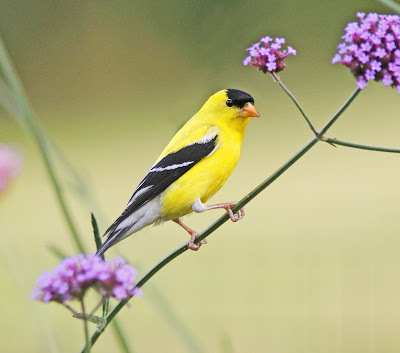
Wonderful review from the National Audubon Society By Chad Witkoof The Stokes Guide to Finches of the United States and Canada Buy Now, HERE
"Beloved by the public, bird enthusiasts, and researchers alike, finches are among our most familiar birds. Yet, they are deceptively complex, presenting some of North America’s most intricate avian life histories and identification challenges. Covering this diverse, multifaceted group in a single, accessible guide requires finesse and expertise. Enter Lillian Stokes and Matt Young.
For decades, Stokes and her husband Don have been trusted voices in birding, sharing their expertise through 35 Stokes Guides—selling more than 5 million copies—and a popular television series, reaching millions of homes. As an award-winning nature writer and photographer, Lillian has also managed an this active blog since 2006. Young, the founder of the Finch Research Network, is a leading authority on North American finches. Together, they have created The Stokes Guide to Finches of the United States and Canada, an authoritative and indispensable compendium that achieves the rare feat of offering something for everyone, making it a must-have for any naturalist’s library.
 A handy comparison of easily confused red finches is one of the books many highlights.
A handy comparison of easily confused red finches is one of the books many highlights.As a reference guide, it is a breath of fresh air. Going beyond the expected identification tips, the book covers everything from fundamental basics (“What is a finch?”) to advanced topics such as the call types, food sources, and distributions of the birds that make up the confounding Red Crossbill complex, of which Young is an expert. As usual, the species profiles are the bulk of the content, and this comprehensive handbook provides detailed life history information for 18 breeding finches, nine vagrants, and 17 Hawaiian honeycreepers, covering vocalizations, breeding, diet, habitat, migration, conservation, and distribution.
One of the book's most notable features is its innovative approach to vocalizations, dividing them into ones given by males, females, and both, not just “calls” and “songs.” This distinction reflects recent scientific insights into oft-overlooked female bird songs, which is important for better understanding and conserving the birds we love. Additionally, the guide presents clear and concise range maps for species, subspecies, and even irruptions, using familiar color palettes and intuitive features like dashed lines and dots.
Beyond the species overviews, chapters covering feeding and attracting finches, movements, irruptions, and research and conservation efforts empower readers in meaningful ways with actionable tips and advice. This blend of practical information and thoroughness makes the guide a powerful resource that perfectly balances breadth and depth in a compact and engaging format.
Tables, charts, spectrograms enrich.Visually, the guide is a feast, immersing readers in the vibrant world of finches. Featuring more than 345 stunning photographs, it provides more than simple images to help with identification points (which are still appreciated when present). From flocks of Evening Grosbeaks filling a tray feeder and Redpolls working through a weedy field to White-winged Crossbills migrating past the dunes of Tadoussac, Québec, the images are emblematic, educational, and inspiring.
Interspersed among these photos and species accounts are informative deep dives and detailed identification guides. Examples include a two-page spread on telling apart common red finches (Purple, House, and Cassin’s) and a four-page layout for distinguishing Common and Hoary Redpolls—still useful despite . Tables, charts, and spectrograms enrich the guide, offering valuable insights into challenging species complexes like Red Crossbill, which is covered in an exhaustive 40-page breakdown.
 Charts detailing cone crop preferences and timing for various crossbill types are just one of the features that make this the ultimate finch guide.
Charts detailing cone crop preferences and timing for various crossbill types are just one of the features that make this the ultimate finch guide.Perhaps Stokes and Young’s most significant achievement, however, is the dedicated section on endangered Hawaiian honeycreepers—descendants of rosefinches from Central Asia who, five to seven million years ago, found their way to Hawai’i and eventually evolved into more than 50 distinct species through adaptive radiation. Unfortunately, habitat loss, human activity, pests, and diseases like avian malaria reduced their numbers to just 16 species today, 11 of which are endangered, with several in fear of vanishing forever soon. At the time of writing this review, the ‘Akikiki is functionally extinct in the wild, with only 0-1 individuals likely remaining (per Young), highlighting the alarming rate at which we are losing this once diverse group of finches.
Historically, Hawai’i’s birds have seldom appeared in North American field or reference guides. This is because the region’s native avifauna shares closer affinities with birds from Asia and Oceania than mainland U.S. birds. However, since the American Birding Association included Hawai’i in their ABA Area in 2016, there has been a significant shift in the collective effort to showcase the remarkable species of Hawai’i and the severe conservation challenges they face in the world’s bird extinction capital. By including the honeycreepers, this book provides the most complete coverage of all U.S. and Canadian finches while raising awareness about the importance of protecting these threatened species.
If it seems from this review as though the The Stokes Guide to Finches does it all, that’s because it does. This is much more than a mere finch identification manual. A testament to these birds’ remarkable depth and diversity, the guide is just as much a vibrant exploration and celebration of finches both familiar and irregular. That it does all of this while balancing rigorous detail with accessibility makes it an exceptional and essential resource for anyone passionate about finches and dedicated to their conservation.

The Stokes Guide to Finches of the United States and Canada, by Lillian Stokes and Matt Young, 352 pages, $21.99. Available here.
Help America's migratory biHe migratory birdsbirds across the Western HemisphereThe Winter Finch Forecast is Out!!
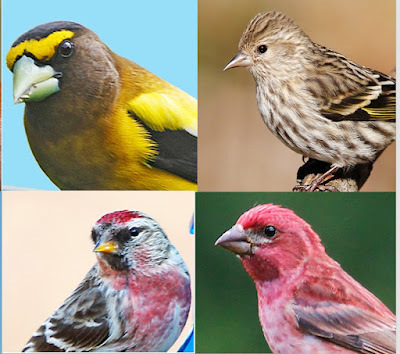
The Winter Finch Forecast suggests there will be good movements of Purple Finches, Evening Grosbeaks and more this winter, read on
26th ANNUAL WINTER FINCH FORECAST 2024-2025
By Forecaster Tyler Hoar
GENERAL FORECAST
"This year, a widespread cone crop reaches from northern British Columbia to eastern Quebec and down the western mountains. While there is a widespread crop, some areas have significant holes caused by insect infestations (Spruce Budworm, Tent Caterpillar, etc.), drought and forest fires. For example, northwestern Ontario, west of Lake Superior, is one area with poor cone crops.
This year’s cone crop across the boreal forest is primarily driven by two significant finch food sources, White Spruce and Tamarack, with White Birch and Balsam Fir also contributing to this food source. Last year, the driver of the Red Crossbill invasion in the east was the bumper Eastern White Pine crop. This year, it appears this species is taking a year off from reproduction for the most part.
To quote one of our cone crop reporters, “Basically any plant with a berry produced this year.” Large areas of the boreal forest have an excellent berry crop for many species, including Mountain Ash, which were observed across several areas.
Areas south of the boreal forest are mostly a mosaic of poor to average crops. Areas of northern Wisconsin and Minnesota and the Adirondacks appear to have a more robust crop than the neighbouring areas.
As the season progresses, significant winter storms, and/or freezing rain events, may be needed to nudge some species out of the boreal forest this winter.
INDIVIDUAL FORECASTS
Forecasts apply mainly to Ontario and adjacent provinces and states. Three irruptive non‐finch passerines whose movements are often linked to finches are also discussed. Follow finch wanderings this fall and winter on eBird, the Finch Research Network, and the Finches, Irruptions and Mast Crops Facebook group for more information.
PINE GROSBEAK
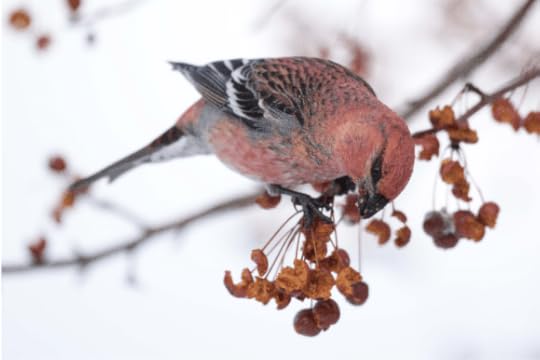 Mark Peck
Mark PeckMost Pine Grosbeaks should remain in the boreal forest with some flight into their traditional wintering areas in western and southeastern Canada and northern New England states as wild food sources to the north are consumed. Areas around Lake Superior and particularly northern Minnesota, may see a larger movement as the weaker crop in northwestern Ontario is consumed. Roaming Pine Grosbeaks will search for fruiting ornamental trees and well-stocked feeders with black oil sunflower seeds.
PURPLE FINCH
 Mark Peck
Mark PeckMost years, Purple Finches migrate south out of Canada. A visible movement is already moving south, as reported by Hawk Ridge Hawk Watch near Duluth, Minnesota, and central New York. This year, the majority should leave Canada with a likely moderate flight to the Great Plains and southern United States. Still, we anticipate small numbers will remain in southern Ontario eastward to the Maritime provinces.
At feeders, they prefer black oil sunflower seeds.
REDPOLL
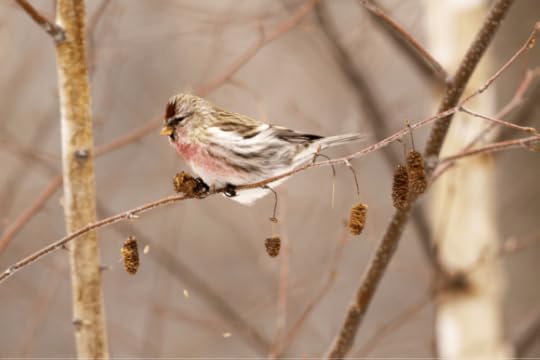 Mark Peck
Mark PeckThe boreal forest appears to have a widespread average birch crop this winter. Some areas not affected by tent caterpillars in northeastern Ontario and Quebec have heavy birch crops. Areas south of the boreal forest from Lake Huron eastward into New England appear to have scattered areas of good White and Yellow Birch crops surrounded by no seed. The alder crop across the boreal appears to be above average. Redpolls enjoy foraging in weedy fields, and if the snow does not cover these fields, this widespread food source, in addition to the tree seed crops, should hold most Redpolls north. Areas in the upper midwestern states and the Maritime provinces may see more Redpoll movement as southbound birds transit the holes in the boreal cone crop.
Watch for Redpolls on birches, in weedy fields, and at bird feeders that offer Nyjer® and black oil sunflower seeds.
In 2024 Common Redpoll, Hoary Redpoll and the Lesser Redpoll in Europe have all been lumped into the same species now called Redpoll. Genetic work found that a supergene was responsible for the Redpoll plumage differences.
See the link below for photos and identification marks of the Redpoll subspecies. They are still unique taxon and we continue to encourage everyone to keep looking at those redpolls! Also see links below for more about them being lumped.
PINE SISKIN
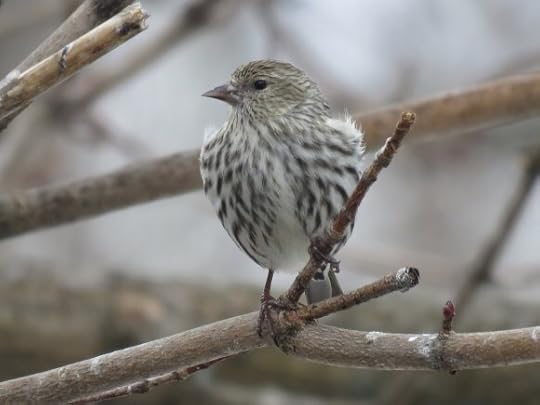 Matt Young
Matt YoungMany Pine Siskins will remain in the boreal and western mountains this winter. Areas from Manitoba eastward affected by Spruce Budworm infestations have a poor cone crop. Siskins that bred in these areas will be on the move. While band recoveries show siskins will move straight across North America from coast to coast, there should be some small movement south in the eastern half of the United States this fall in search of food.
At feeders, they prefer Nyjer® seeds and black oil sunflower in silo feeders.
WHITE-WINGED CROSSBILL
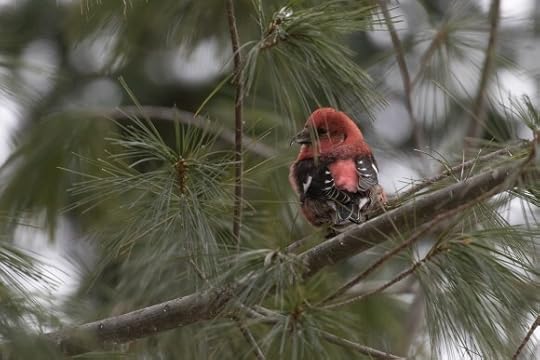 Ryan Mandelbaum
Ryan MandelbaumWith a good White Spruce crop across most of the boreal forest and good multi-species cone crops in the western mountains, most White-winged Crossbills should stay in the boreal. Some birds will drift out of this crop throughout the winter. In areas of poor cone crops, ornamental spruces in urban areas laden with cones will be used by crossbills.
Significant winter storms and freezing rain events can cause flocks of crossbills to move out quickly in search of accessible food. Watch for crossbills and other finches in neighbouring areas, primarily to the south, after these weather events.
RED CROSSBILL
 Mark Peck
Mark PeckMost of last year’s invasion of western-type Red Crossbills (Type 2 and 4) appear to have returned west over the summer. Red Crossbills, primarily the Northeastern Type 12, are common in the Adirondacks and eastward into Nova Scotia, feeding on the Red Spruce crop. There are more modest numbers from Algonquin Provincial Park over to the upper Great Lakes states. Leftover Type 2 and 4 will likely be scattered in very small numbers across the area, with a few usual Type 1s around in small numbers as well.
The Red Crossbill types are usually impossible to identify without recordings of their flight calls. Recordings can be made with a smartphone and identified to type. Types can be identified by emailing Matt Young (info@finchnetwork.org) or uploading recordings to an eBird checklist. Recordings uploaded to eBird checklists are deposited in the Macaulay Library.
EVENING GROSBEAK
 Mark Peck
Mark PeckThere was a widespread and diverse berry crop across the eastern boreal forest in 2024. The berries provided the families of fledging Evening Grosbeaks with an ample food source to replace the Spruce Budworm caterpillars as they spun their cocoons and pupated into adults. By the end of August, many areas with ample berries were barren, having been consumed by the grosbeaks and other fruit-loving vertebrates.
Areas containing viable ash and maple seeds may also hold some flocks in the southern boreal and adjacent forests to the south into the early winter.
With a visible movement at Tadoussac in early August, there should be a moderate flight of Evening Grosbeaks southward this fall. Evening Grosbeaks should visit areas from the Maritime provinces south towards Pennsylvania. Areas even further south to the mid-Atlantic states may see grosbeaks this winter. With Spruce Budworm outbreaks becoming more widespread and scattered around Lake Superior, western Great Lake states may see even more movement this winter.
Evening Grosbeaks in northwestern Ontario westward should move out of the boreal forest, looking for feeders in towns or suitable food sources further south.
At platform feeders, Evening Grosbeaks prefer black oil sunflower seeds. Evening Grosbeaks will look away from feeders for maple and ash trees still holding seeds. See the link below for Evening Grosbeak call types.
THREE IRRUPTIVE PASSERINES
Movements of these three passerines are often linked to the boreal finches.
BLUE JAY
In eastern North America westward to Manitoba the deciduous tree crop (they love acorns on oaks) appears below average with scattered areas of average crops, so expect a moderate to strong flight this fall.
RED-BREASTED NUTHATCH
The Balsam Fir crop is widespread in some areas with a great crop, and is completely absent in other areas across the boreal forest. As a result, we can expect a moderate flight of Red-breasted Nuthatch, with a few birds already being noted near the Gulf Coast.
BOHEMIAN WAXWING
Most Bohemian Waxwings will likely stay in the north because native Mountain Ash berry crops and other berries are good across much of the boreal forest.
With the poorer crops in northwestern Ontario, northern midwestern states may see more widespread movements of Bohemian Waxwings.
Small numbers will probably arrive mid to late winter in traditional areas from central Ontario eastward into the Maritime Provinces, New England, and northern New York as winter progresses and food resources dwindle. If some move south, this species will forage on Buckthorn and planted European Mountain Ash berries and ornamental crab apples.
We’re excited to again bring to you the translation of the Winter Finch Forecast in French. It is greatly appreciated! Thanks again to Jessé Roy-Drainville and Alexandre Terrigeol at Observatoire d’oiseaux de Tadoussac, Quebec."
The forecast is put out by the The Finch Research Network (FiRN) which is a nonprofit, and was granted 501c3 status in 2020. We are a co-lead on the International Evening Grosbeak Road to Recovery Project, and have funded almost $13,000 to go towards research, conservation and education for finch projects in the last couple years. FiRN is committed to researching and protecting these birds like the Evening Grosbeak, Purple Finch, Crossbills, Rosy-finches, and Hawaii’s finches the honeycreepers.
October 3, 2024
Great Book Review: The Stokes Guide to Finches of the United States and Canada

BUY THE BOOK NOW, click HERE.
"BOOK NOTE: IT’S FINCH TIME! (Review from The Birding Community E-Bulletin) If you ever wanted a way to unravel the complexities of identifying and understanding better the world of North American finches – grosbeaks, rosy-finches, crossbills, goldfinches, and the other myriad finches – you now have a book that should seriously help you in your quest. It’s The Stokes Guide to Finches of the United States and Canada (Little, Brown and Company, 2024) by Lillian Q. Stokes and Matthew A. Young.
The birds in the guide are smartly arranged into three groups: 18 main breeding finches, 9 vagrant finches, and the 17 endemic finches (honeycreepers) of Hawaii. But the book contains much more than the ID specifics – with revealing color photos for each species (including plumages, subspecies, and voice). The book also has excellent range maps, wonderful and brief information on the usual life-history for each species, summaries on up-to-date research, extensive details to help understand finch irruptions, conservation, research, attracting finches, and more. The formatting of the book is both creative and user-friendly. Yes, the book presents just about everything you wanted to know about finches, including things you might not even have considered!Some of our favorite – and sometimes surprising - sections are the readable and often entertaining “Quick Takes,” that introduce each species (some highlights: Pine Grosbeak, the rosy-finches, House Finch, Common/Hoary redpoll, and the Red Crossbill complex). These sections are different, readable, and even entertaining to read.Particularly noteworthy is the portion of the book on the unique Hawaiian honeycreepers. And do not miss the brief and creative section at the end of the book on Conservation and Research, replete with ongoing topics of interest with questions yet to be answered in the finch-world, and the challenges presented in a section on “How you can help.”The timing of this book by Stokes and Young is perfect, ideal to guide us through the finches we encounter, pursue, and even attract this fall and winter. It’s also sure to become an essential resource to take us into the field and into the future."You can sign up to get the E-Bulletin, a great publication, HERESeptember 14, 2024
STOKES FINCH GUIDE IS TOP NEW RELEASE! ORDER NOW!
 The Stokes Guide to Finches of the United States and Canada will be published Sept. 17, 2024. Click here to order.
The Stokes Guide to Finches of the United States and Canada will be published Sept. 17, 2024. Click here to order.
August 15, 2024
Stokes Guide to Finches, Lillian Stokes and Matt Young, Book Signings

Just had a long working weekend with my coauthor Matt Young, for our new book, The Stokes Guide to Finches of the United States and Canada which come out soon, September 17th!. We worked on our upcoming talk that we will be giving at a number of places (including being keynote speakers at The Biggest Week in 2025, Harris Center in NH and NH Audubon this fall, Acadia Birding Festival 2025), met with the American Bird Conservancy to hear about all the great work they are doing to save endangered Hawaiian Finches (which are covered in our book), and recorded one of many podcasts we will be doing (Hannah and Erik Go Birding's Bird Nerd Bookclub to be released right before our book comes out, and will also be doing ICW The Urban Birder, and ABA podcast). So excited, and will keep you posted on more of all of this soon! #StokesFinchGuide
July 16, 2024
DRAGONFLIES AND DAMSELFLIES FOR BIRDERS
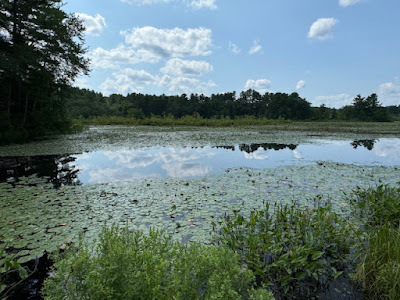
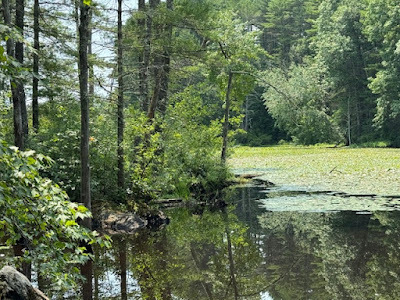
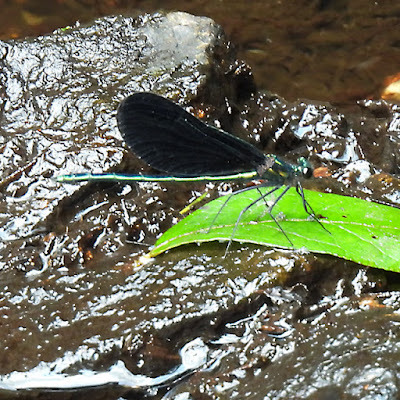
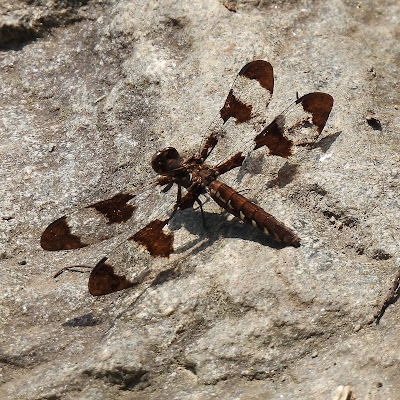
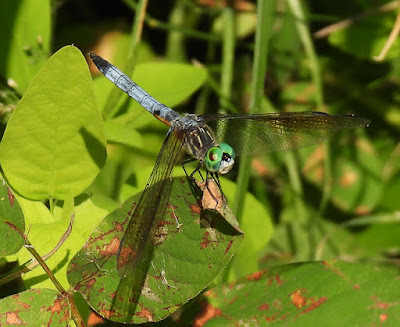
 Escape into nature part 1: Dragons and damsels. Visited 5 wetland areas on Sunday and saw some beautiful dragonflies and damselflies. They are the "flycatchers" of the insect world, darting out to catch smaller insects. The males often patrol stream and pond banks in a territory, waiting for females to mate with. Such amazing creatures! When the birding slows down in the middle of the day get out your binos and camera! Learn all about them in our Stokes Beginner's Guide to Dragonflies
Escape into nature part 1: Dragons and damsels. Visited 5 wetland areas on Sunday and saw some beautiful dragonflies and damselflies. They are the "flycatchers" of the insect world, darting out to catch smaller insects. The males often patrol stream and pond banks in a territory, waiting for females to mate with. Such amazing creatures! When the birding slows down in the middle of the day get out your binos and camera! Learn all about them in our Stokes Beginner's Guide to Dragonflies

June 25, 2024
Butterflies Through Binoculars
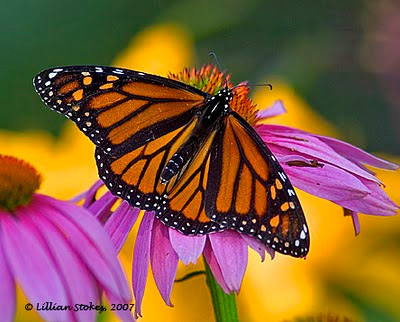
Monarch Butterfly. They lay their eggs on milkweed and their caterpillars feed on this plant.

Great Spangled Frittillary on Purple Coneflower
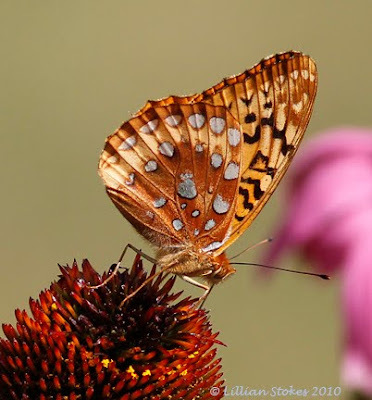
Close-up of Great Spangled Fritillary
 American Lady Butterfly, told by the two eye spots on underside of the hindwing
American Lady Butterfly, told by the two eye spots on underside of the hindwing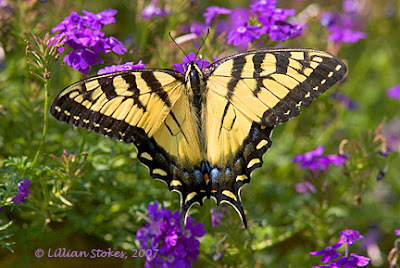 Tiger Swallowtail Butterflies are unmistakable
Tiger Swallowtail Butterflies are unmistakable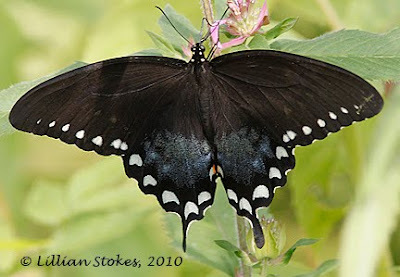 Spicebush Swallowtails can be told from other big, dark swallowtails by their single row of prominent white dots inside the margin of their forewings.The larvae of Spicebush Swallowtails feed on spicebush and sassafrass.
Spicebush Swallowtails can be told from other big, dark swallowtails by their single row of prominent white dots inside the margin of their forewings.The larvae of Spicebush Swallowtails feed on spicebush and sassafrass.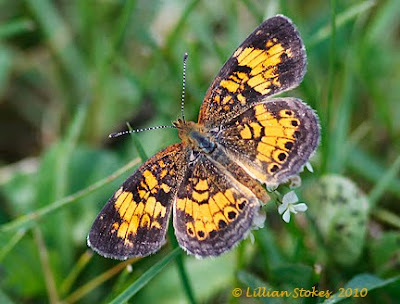
Pearl Crescent butterfly. Scores are feeding on white clover on our path so we keep the path mowed high to preserve the clover flowers for them.
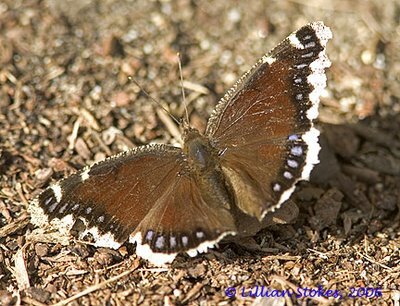 Mourning Cloaks are widespread across much of North America. They are one of the few butterflies who overwinter as adults, finding protected places in log piles, nooks, or under loose bark, and when they emerge in the spring they look worn, as this butterfly does. They are one of the longest lived butterflies and some may live as long as 10 months. Mourning Cloaks feed on sap and fruit.
Mourning Cloaks are widespread across much of North America. They are one of the few butterflies who overwinter as adults, finding protected places in log piles, nooks, or under loose bark, and when they emerge in the spring they look worn, as this butterfly does. They are one of the longest lived butterflies and some may live as long as 10 months. Mourning Cloaks feed on sap and fruit.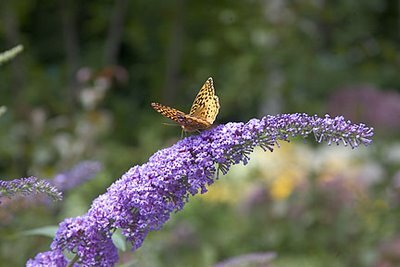 Our butterfly bushes will bloom soon and they're magnets for the butterflies. Here's a Great Spangled Fritillary butterfly on one of them.
Our butterfly bushes will bloom soon and they're magnets for the butterflies. Here's a Great Spangled Fritillary butterfly on one of them.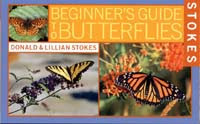
We've written two books to help you attract and identify butterflies.Stokes Beginner's Guide To Butterflies, has an easy ID key to help you quickly identify the butterflies you see by size and shape.
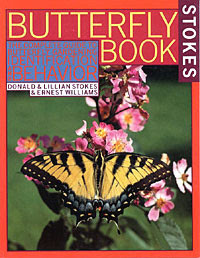 Stokes Butterfly Book gives you plans for a butterfly garden, lists and photos of butterfly plants, and chapters, with color photos, on the identification, behavior and caterpillars of common butterflies. Both are available at amazon.com and stores.
Stokes Butterfly Book gives you plans for a butterfly garden, lists and photos of butterfly plants, and chapters, with color photos, on the identification, behavior and caterpillars of common butterflies. Both are available at amazon.com and stores.When the birding is slow, and it's the middle of the day, a wonderful thing for birders to do is look for butterflies. Butterflies are colorful flying creatures, just like birds. The identification skills birders already have can be transferred to identifying butterflies.Look at butterflies through your binoculars, no need to catch them in a net.
The hot weather favors butterflies as they need to warm their bodies to fly. They need to get their body temperature up to 85 to 100 degrees Farenheit in order to fly well. Adult butterflies come to flowers for nectar, lay their eggs on special host plants, which can be unique to each species of butterfly. The eggs hatch, larva feed on the plant then turn into a pupa or crysalis from which the adult butterfly will emerge. A complete cycle or generation is called a brood, and butterfly species can go through from just one to as many as four broods per year, depending on the species and the number of warm months. Different butterflies are on the wing at different times during the summer, so you will continue to see new species.
There are about 17,000 species of butterflies in the world. In North America there are about 700 species but only a small fraction are common and likely to be seen by the average person.
When you see a butterfly watch it closely for several minutes. Observe how it flies, its size, shape, and the colors and patterns on its wings, both above and below.
Start by knowing the major families of butterflies that are distinctive. Below are some:
Swallowtails - are our largest butterflies and most have long tails coming off their hind wings.
Whites and Sulfurs - these are all medium-sized butterflies that are predominantly white or yellow.
Gossamer Wings - this group is easy to identify since it includes all of our smallest butterflies, such as the blues, coppers and hairstreaks, and metalmarks. The blues tend to be iridescent blue, coppers are often copper, hairstreaks often have hairlike tails on their hind wings, and metalmarks often have metallic spots on their wings.
Brush-footed Butterflies - this is a large and varied group of medium-sized, generally dark-colored butterflies with such strong and rapid flight they are hard to follow. Their is no one field characteristic, besides their flight, that makes them easy to identify as a group.
Satyrs - these are medium-sized butterflies that are almost all brown, often with darker eye-spots on their wings. They have a weak and bobbing flight and are often seen at woods edges or among grasses.
Skippers - are small butterflies whose flight is extremely rapid and erratic. They are mostly rich brown or orange-brown
Enjoy the butterflies as well as the birds!
June 20, 2024
Hot Weather Tip for Birds: An Easy Birdbath
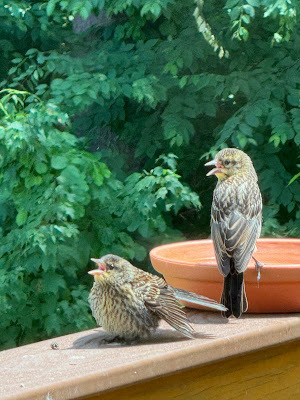
It's 96 degrees. For an easy, inexpensive birdbath, try using a saucer that goes under a flowerpot. I just refilled this bird saucer with fresh cold water and two Red-winged Blackbird juveniles showed up. One drank and the other with spread wing might have been sunbathing (which birds do by lying with spread wings, to help get rid of parasites in feathers). Their mouths are open because they are panting, it's how birds cool off. I am just trying to help the birds and stay out of the high heat, it's like an oven out there!
June 18, 2024
10 TIPS TO HELP BIRDS IN HOT WEATHER
 Birds need water to drink,
Birds need water to drink, and bathe.
and bathe.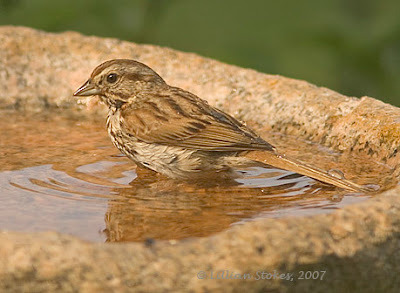 "Hey, where's the towel and the frozen daquiris?"
"Hey, where's the towel and the frozen daquiris?"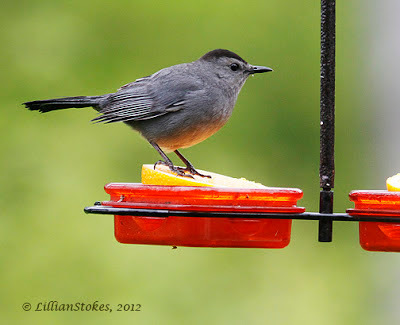 Orange halves are a refreshing treat in warm weather for this Gray Catbird.
Orange halves are a refreshing treat in warm weather for this Gray Catbird.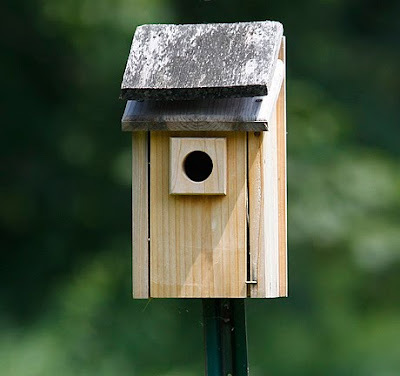 An extra roof cools off the bird house above and below.
An extra roof cools off the bird house above and below.
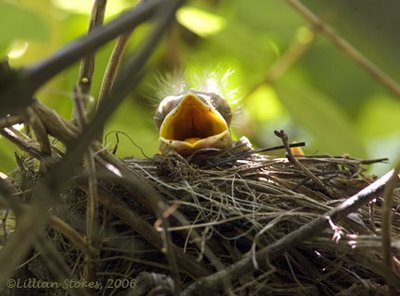 This baby American Robin cooled off the only way it knows how, by panting. Birds have no sweat glands and so cool themselves by rapid respiration with their mouths open.
This baby American Robin cooled off the only way it knows how, by panting. Birds have no sweat glands and so cool themselves by rapid respiration with their mouths open.
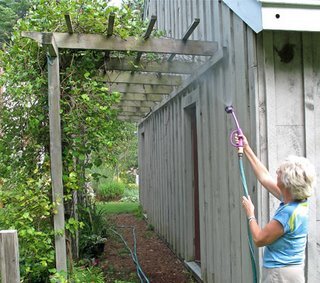 I used the mister setting on the hose to cool off the robin nest by misting the air and foliage above.
I used the mister setting on the hose to cool off the robin nest by misting the air and foliage above.
 Hummingbird Feeder with shade roof.
Hummingbird Feeder with shade roof.The weather has been crazy, ranging from one extreme to another. Here in NH we just had 90 degree summer weather, now it has cooled off a little. Much more hot weather is coming as we go into summer. So when the temperature climbs, here's some tips to keep your feathered buddies cool:
1. Bird baths, bird baths, bird baths! Birds need water to bath and drink in hot weather so buy a bird bath. You can even use any wide flat container for a bird bath, such as the lid of a trash can or a large saucer that it used under a flowerpot.
2. Choose a bird bath that is shallow and has a non-slip surface. Small birds do not like to bathe in deeper water. You can add flat rocks to a bird bath that is too deep in order to create a shallow ledge for small birds to land on to drink and bathe.
3. Add a dripper, bubbler or to your bird bath. The sound of moving water will be a magnet for the birds and alert them to the presence of a water source.
4. Keep the water in your bird bath cool by adding ice cubes several times a day, or refilling the bird bath with a hose. You can also put out refreshing treats like cold orange halves which many birds, such as orioles and Gray Catbirds, will enjoy.
5. Birds will feel safer if the bird bath is placed in a more open area so no predators can hide nearby. Provide a stake or branch placed in the ground near the bird bath, if no landing places exist near it, so birds have a place to wait their turn at the bath.
6. Air condition your bird houses by adding a second roof for shade. We nail on a piece of plywood, using long nails and only nailing them part way into the original roof. This leaves an air space between the two roofs of about an inch. The second roof shades the first roof plus the airspace between the roofs acts as an insulator, keeping the bird house cooler. In some cases we have just shaded the roof of a bird house with piece of cardboard.
7. Misters are coolers. Misters can be bought to attach to a bird bath, or clip to shrubs near a bath. They spray a fine mist that birds can fly though, or rub against the wet shrubbery. Hummingbirds will often fly through misters, or even a garden sprinkler.
8. Use a mister on a hose. Our hose has a mist setting on the nozzle. We have misted the foliage and area above a robin nest to cool off the babies in extreme heat.
9. Think Shade. Birds will seek out shady areas and lie low in the worst heat of the day. If you do not have shade on your property plant some shade trees and big shrubs. Place bird feeders in a shady area during summer.
10. Shade hummingbird feeders. Place them in shade. Some feeders, comes with their own shade/rain roof, including an ant moat on the roof. You can also buy baffle-type shields and hang them above a feeder. Don't forget to change your hummingbird nectar solution every 2 days in really hot weather.
And tips for you....
Stay out of the sun and heat in the middle of the day, wear a hat and sunscreen when you do go out and, at the end of the day, after you have taken care of the birds, relax in a shady place, get out your binos and The New Stokes Field Guide to Birds: Eastern or Western Region, watch your birds and have a nice cold drink ,,,aaahhh!
June 14, 2024
Bluebird Nesting Cycle, what you should know!
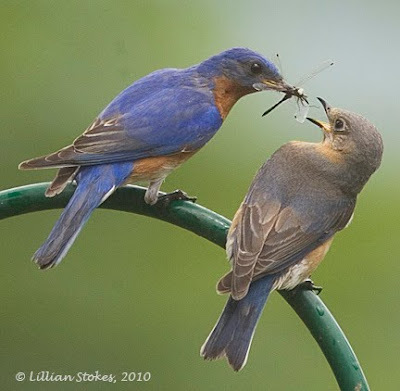
Birds are in full time breeding mode right now. Many birds do mate-feeding as part of their courtship and nesting. Males will get food and feed it to the female. She may quiver her wings as she is getting fed. In bluebirds mate-feeding continues from the start of pairing on into the nestling phase. Cardinals and other birds also do this. Whether it's just part of the pair-bonding, extra nutrition for the female or other reasons, it's just fascinating to watch.
People do not always understand a bird's breeding cycle. Someone just asked us"I put my bluebird house up late. They did start making a nest about a week and half ago. I haven't seen them around for a whole day. I did check the nest I could not see any eggs. Could they have possible left the nest by now?"
To help you better understand bird behavior, in general here is some basic information on the breeding cycle of birds. This is generalized information for most songbirds, certain species may vary from this.
Breeding begins by a male singing, forming a territory and trying to attract a female. If he is lucky, a female bird will choose him and join him on the territory. He then usually diminishes or stops singing.
The female builds the nest and it may take a day or several days. There may be a pause before the eggs are laid. The pair will mate, then the female lays 1 egg per day until the clutch is complete. Most songbirds lay 3-6 eggs. She usually lays the egg in the morning and does not stay near the nest the rest of the time. So if you see 1 or 2 eggs in a nest it does not mean it is abandoned, chances are the female will come back the next day and lay another egg until she has a complete clutch.
Then incubation begins. It is done mostly by the female and usually lasts about 12 to 14 days (12-18 days for Eastern Bluebirds). During this time the female is quiet and the male stays somewhat near and does not sing.
When the eggs hatch both parents become very active bringing food to the nest. They carry away from the nest fecal sacs, little white packages that are the droppings of the young. This keeps the nest clean. The young, called nestlings, stay in the nest for about 12-14 days (longer for birds thart nest in birdhouses, for Eastern Bluebirds it's 16-21 days). The young at first have very few feathers. Then they have "pin feathers", feathers enclosed in sheathes. By the time they are ready to leave, the feathers have broken out of the sheathes, the young are fully feathered, and they call loudly.
When the young "fledge", or leave the nest they are called "fledglings". At first they may not be able to fly that well and for the first few days stay in the vicinicy of the nest. They are still fed by the parents for another several weeks. The fledglings often stay scattered in trees and call constantly. So if you hear constant chirping and see adult birds carrying food to different bushes or trees, chances are they are feeding fledglings. During the fledgling phase the adults may start a new brood. The male may sing again, mate with the female, and she will start a new clutch of eggs. even while he is still feeding fledglings from the first brood. The fledglings will eventually learn to feed themselves and the parents stop feeding them. and so the whole thing starts over.
Lillian Q. Stokes's Blog
- Lillian Q. Stokes's profile
- 2 followers



